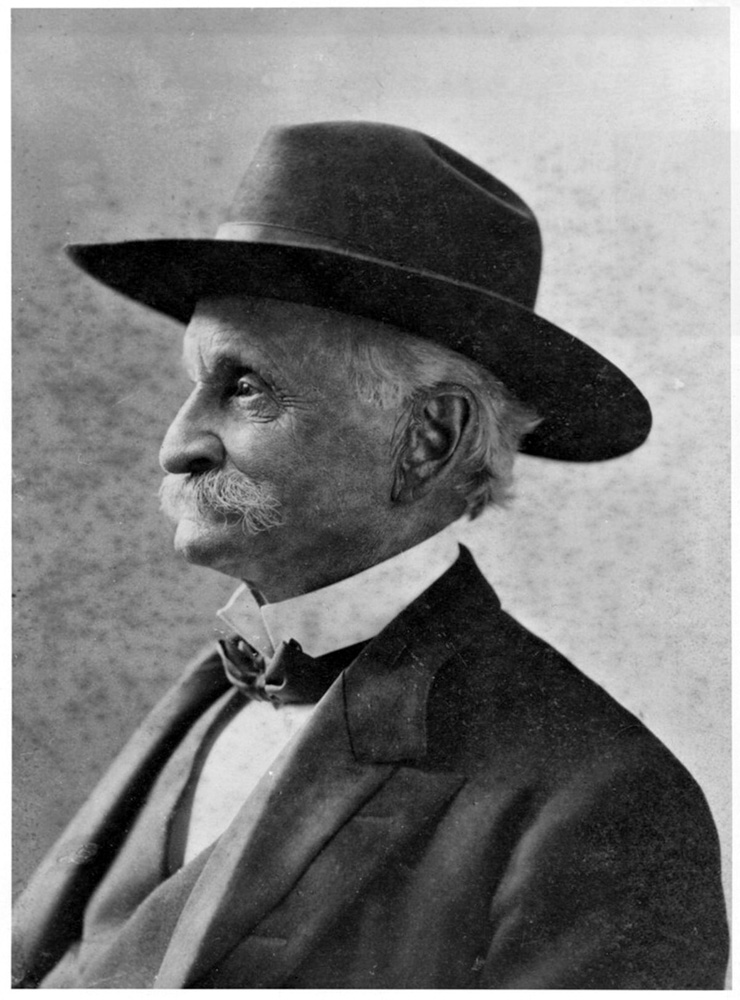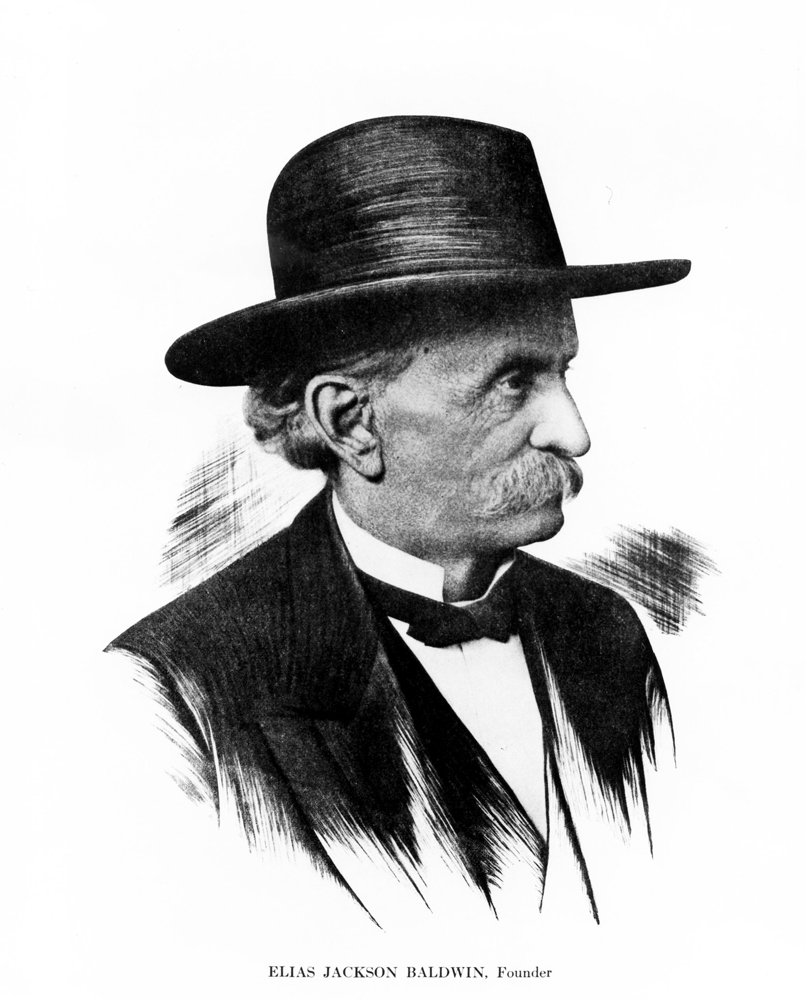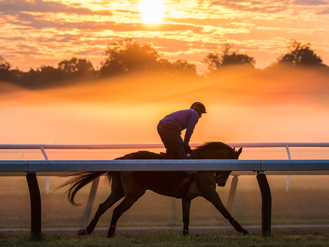Elias J. "Lucky" Baldwin
Elias Jackson Baldwin lived a life full of adventure. Fortune smiled upon him in numerous undertakings, but Baldwin never much cared for his nickname, “Lucky.” He accepted the moniker but resented its implications, once commenting “I’ve worked hard for everything I’ve gotten in life.”

2018
April 3, 1828, Hamilton, Ohio
March 1, 1909, Arcadia, California
Biography
Elias Jackson Baldwin lived a life full of adventure. Fortune smiled upon him in numerous undertakings, but Baldwin never much cared for his nickname, “Lucky.” He accepted the moniker but resented its implications, once commenting “I’ve worked hard for everything I’ve gotten in life.”
Baldwin’s determination, hustle, and business acumen allowed him to become one of the wealthiest men in America in the second half of the 19th century. He found success in real estate, mining, and the stock market. One of Baldwin’s favorite pastimes was thoroughbred racing, a game in which he became a California pioneer as an owner, breeder, and track developer.
Born in Hamilton, Ohio, on April 3, 1828, Baldwin was the fourth of 14 children in his family. He received little formal education and at the age of 18 eloped with neighbor Sarah Ann Unruh — the first of his four wives — and relocated to Valparaiso, Indiana, to become a farmer. While in the Midwest, Baldwin also opened a saloon and grocery store before his restless nature needled him into a new adventure.
In 1853, Baldwin relocated to California at the height of the Gold Rush. Instead of prospecting for gold, Baldwin decided his future wealth lay in providing food, supplies, and accommodations for others. He sold his Indiana businesses and used the profits to purchase wagons and supplies for the journey west. With his wife and first daughter along for the escapade, Baldwin loaded a wagon train with tobacco, brandy, tea, and other provisions and hired several men to help drive and provide security. At one point during the arduous trip, Baldwin scouted ahead and got lost. Having almost starved to death, Baldwin was saved by friendly Native Americans who brought him back to the wagon train. In Utah, his caravan was attacked by less friendly Native Americans and Baldwin and his family barely escaped with their lives. In Salt Lake City, he sold the bulk of his brandy to the brother of Brigham Young for a considerable profit. He later sold the tobacco and tea and used those profits to purchase more horses.
After a five-month trek, Baldwin arrived in San Francisco. He had more than doubled his capital while crossing the country and immediately bought the Temperance Hotel with $5,000 cash. He sold the hotel less than a month later for a $5,000 profit. Baldwin quickly became active in the real estate market and purchased a livery. He bought and sold various goods and invested heavily in the stock market, becoming a key player in the San Francisco Stock Exchange. He later started a brick-manufacturing plant, producing building materials that were used to construct the U.S. Mint and the fort on Alcatraz Island.
When a significant silver mine was discovered in Nevada in 1859, Baldwin arrived with a load of timber. In payment for the materials, he received 2,000 shares of the Ophir Mine. Using his profits, he slowly invested in several other mines. While in Nevada, Baldwin met a group of British sportsmen who invited him to join them in India on a big game safari. Baldwin was up for the adventure and prepared to leave for India.
In another stroke of good fortune that cemented his reputation as “Lucky” Baldwin, he left instructions with his broker to sell his mining stock if it fell below $800 a foot (gold and silver were often sold at the time by the foot). Upon returning to San Francisco, Baldwin learned that his stocks had indeed fallen below the threshold price he specified, but his broker had been unable to sell because Baldwin had taken the key to the safe holding the stock certificates. In an incredible stroke of good fortune, the stock price had rebounded to a spectacular level, creating a multimillion-dollar profit for Baldwin. Using his stock profits, estimated to be more than $3.5 million, Baldwin branched out in his investments.
In 1875, Baldwin bought his 63,000-acre Rancho Santa Anita in California and later subdivided a portion of the land, creating the towns of Arcadia and Monrovia. It was at this time that Baldwin began his association with thoroughbred racing and breeding.
One of the first prominent breeders in California, Baldwin raced under the name Santa Anita Stable. His greatest horse was Hall of Fame member Emperor of Norfolk. Widely considered the finest California-bred until Swaps emerged almost 70 years later, Emperor of Norfolk won 21 of 29 starts, including the American Derby at Chicago’s Washington Park in 1888, arguably the most prestigious race in the country at the time. Baldwin horses also won the American Derby in 1885 (Volante), 1886 (Silver Cloud), and 1894 (Rey el Santa Anita). In the 1894 edition, Rey el Santa Anita defeated the previously unbeaten Domino, a future Hall of Famer.
Baldwin operated one of the most successful racing stables of the 1880s, winning major races throughout the country. In 1885, his stable won 14 stakes races at seven different tracks. His horses also won 15 of their 25 starts that year at Saratoga. Baldwin’s champion mare Los Angeles, racing from 1887 through 1891, won 48 times and finished in the money 84 times in her 110 starts. Her 34 stakes wins included a record 16 at Saratoga, including the 1891 Saratoga Cup over Hall of Famer Kingston.
On Dec. 7, 1907, Baldwin opened the original Santa Anita track on his Rancho Santa Anita property. The Los Angeles Herald provided a positive review of Baldwin’s new facility: “After the day was done nothing but words of praise — aside from the comments on the car service — were heard on all sides. The beauty of the track, the class of horses, betting facilities, ample room to sit and stand as suited the fancy — everything was satisfactory, and Santa Anita’s first day closed in a blaze of glory, long to be remembered as a fitting baptismal for the handsomest and most perfect track in America.”
Baldwin’s track was successful in its short run, but in February of 1909 the Walker-Otis bill passed and outlawed “pool selling” in California, making it impossible for bookmakers to ply their trade. The end of racing in California soon followed and Lucky Baldwin died of pneumonia at his ranch at the age of 80 less than a month after the anti-gambling bill became law.
Baldwin left behind an estate reported to be worth $25 million. Baldwin’s obituary in the San Francisco Call described him as the “most noted figure of American turf,” while the Los Angeles Times referred to him as the “King of the Turf.”
One of Baldwin’s children, Anita Baldwin, was among the group, led by Dr. Charles H. Strub, that brought racing back to California with a new Santa Anita Park, which opened on Christmas Day 1934.
Achievements
Won the American Derby — 1885, 1886, 1888, 1894
Media








